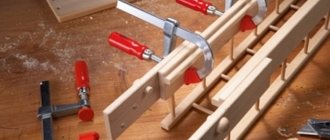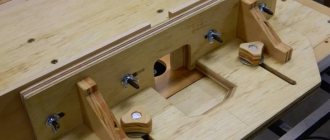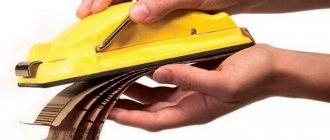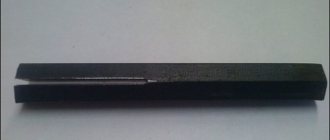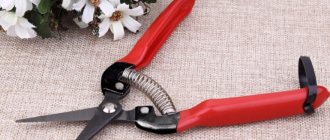Classification
There are many options for classifying garden forks - by the shape of the teeth, by materials, width, etc. One of the clearest ways to divide these tools into groups is to classify them by purpose. Gardeners use pitchforks for different purposes: caring for flowers, digging garden beds, spreading compost.
Depending on the “area of specialization,” pitchforks are divided into three large groups:
- for tillage;
- compost/manure;
- hay
For tillage
Tillage forks are distinguished by their massiveness. Their teeth are large and strong, which allows them to be used for the toughest jobs. Such work includes digging out weeds, uprooting bushes, leveling and digging up the ground. Digging models are often equipped with an additional support under the foot - to immerse the fork in the soil.
PALISAD 63808
The forks are made of medium carbon steel and have a non-folding design. The handle is attached to the canvas using manual arc welding. The width of the working surface is 18 centimeters. To increase the service life, the handle and working part are covered with a protective layer of powder enamel. The model is used for loosening and digging soil and digging up tuber crops.
Pros:
- two-component handle;
- protective layer against corrosion;
- metal stalk;
- a light weight.
| Nikolai | Anna |
| Vila showed excellent results in practice. I bought it for digging up potatoes in the garden and loosening the soil. Doesn't slip out or break on clay soil. | I was looking for a light and convenient tool for working in the garden. I chose Palisad because I heard a lot of good reviews about their products - I didn’t regret it. This is not the first season I have been using it, sometimes my husband sharpens his teeth. |
FIT 76994
Equipped with four flat teeth and a wooden handle. Carbon steel was used in the manufacture of the model, which increases strength and resistance to corrosion. The height of the fork is 1.4 meters. Weighing 1.8 kilograms, the product lies comfortably in the hands and does not cause discomfort during prolonged use. The forks are designed for excavating soil in garden plots.
Pros:
- reliable working surface made of carbon steel;
- long service life;
- high-quality assembly materials;
- low price.
| Michael |
| I took the fork for country use - digging beds, carrying straw, grass, etc. The tool copes with its tasks perfectly. The only “but” is the weight, which surprised me. All my previous pitchforks were lighter. |
What tools and materials will be required for manufacturing
To make a miracle shovel for digging, you need to stock up on the following materials and tools:
- welding machine;
- sharpening machine;
- metal rod;
- 2 metal corners 50 and 60 cm long;
- pipe with a diameter of 15 mm;
- M10 bolts (2 pcs.).
All materials are standard. But it is especially important to find a good rod. It can be hexagonal, square or round - it doesn't matter. The main requirement is a diameter of 10 mm. Then the entire design of the miracle shovel will be reliable, which will allow you to dig even dense soil.
There are several types of garden shovels for summer residents, which are ideally designed to perform certain jobs.
Compost/manure
Composting forks are used for transporting or distributing humus and manure. These models differ from the classic design by curved teeth that form a bucket. This recess makes carrying the compost more convenient, allowing you to grab more product at one time.
COURSE 76991
The welded fork is equipped with four tines and reaches a height of one and a half meters. The handle is made of wood. The work surface is made of steel to increase durability. The model weighs 1.2 kilograms. The fork is considered universal and is suitable for several purposes: digging, transferring manure and compost, and transporting hay.
Pros:
- steel blades;
- a light weight;
- ease of use;
- versatility.
| Irina | Innocent |
| The fork easily penetrates the ground, compost and easily digs up the soil. The quality of the product is at a high level - the teeth do not bend or rust. For now I'm doing without a sharpener. | High quality design with thickened teeth. I take this fork in cases where I need to fertilize the garden with manure. The blades do not bend under the weight and hold the mass well. |
ROS 76992
The four-horned fork is used for gardening and compost processing. The working surface is made of carbon steel, and the handle is made of wood. The height of the fork is one and a half meters. The 27-centimeter width of the product allows it to be used for working with hay. Thanks to its moderate weight, the fork fits comfortably in your hands and is suitable for extended use.
Pros:
- high quality materials;
- optimal height;
- durable carbon steel blade;
- low price.
| Dmitriy |
| Classic fork with wooden handle. The convenient bend of the handle and large teeth work well with both manure and soil. At first the instrument seemed a bit heavy, but I soon got used to it. |
FISKARS Solid 1026687
The forks consist of three elements - a steel handle, hardened teeth (4 pieces) and a D-shaped plastic handle. The height of the fork is 1.2 meters. The ergonomic design allows you to comfortably use the forks for several hours. Stainless steel is protected from corrosion and designed for a long service life.
Pros:
- ergonomic handle;
- durable stalk with round cross-section;
- welded connection of the handle and the working part;
- quality paint.
| Konstantin | Zhanna |
| I took the Fiskars fork to replace the old Soviet one. I had my doubts about the plastic handle, but I bought a good brand. So far I’m happy with the purchase - I’m cultivating the garden with a fork for the first season. For my above-average height, the length seems a little short, but this is not fatal. | Reliable and strong fork, fully consistent with the stated characteristics. There are no problems with it in the garden - it takes soil, compost, and hay. Sometimes I use it when uprooting bushes. |
Sennaya
Hay forks or hay forks are used for carrying hay and distributing manure. Their distinctive feature is their long teeth, the number of which varies from 3 to 5 pieces. These teeth reach 70 centimeters in length. They are not suitable for active work with the soil, since they require less load. Sometimes there are universal hay models that are used for several tasks.
PALISAD 63801
The forks are equipped with four teeth, which are made of medium carbon steel (like the tulle). In the manufacture of the handle, the highest grade elm was used, which is responsible for strength and comfortable grip in the hand. The teeth are coated with powder enamel to protect against premature destruction. The handle is attached to the canvas using glue and rivets. The height of the structure is 1.2 meters.
Pros:
- matte finish of the handle;
- protection of steel elements with powder enamel;
- elm cutting;
- simplicity and ease of use.
| Boris | Andrey |
| It's nice to pick up a tool made of high-quality steel. I use a fork to carry grass and hay, and sometimes loosen the soil with it. The design fits comfortably in the hand and weighs almost nothing. | A good comfortable fork that is comfortable to work with for half a day. Perhaps the price is a bit steep. But, given the bad experience with budget models, I'm willing to pay for quality. |
SIBRTECH 63807
The forks consist of metal and wooden elements. The teeth and crown are made of medium carbon steel. To create the cutting, hardwood of the highest grades was used. The wooden handle is varnished for safe use and protection from splinters. The model weighs 1.6 kilograms. All steel parts are treated with powder enamel to prevent corrosion.
Pros:
- ease of use;
- high-quality assembly materials;
- low price;
- efficiency and reliability.
| Tatiana | Margarita |
| A simple fork that is suitable for regular gardening. I chose this model because of the low price and protective coating, because... the blades of the previous fork began to disintegrate. | I spent a long time choosing between a plastic and wooden fork. I settled on wood - the manufacturer’s promise to use only the best wood worked. Over the course of a year of working in the garden, the fork did not bend or crack, as happens with other specimens. |
Are you here
Questions can only be asked after registration.
Please login or register. Maybe someone made such pitchforks? Don't want to reinvent the wheel, please share your experience. I’m also interested in anyone who has experience with a homemade sprayer for treating crops, with spray heads. Thanks in advance.
At one time, when I worked on the farm, we bought a KUN with a lance for loading rolls, it didn’t take long. Then they made homemade ones using the same principle and walked for a long time. They took the axle shaft from the zil, sharpened it in a lathe (a lot of cutters break) and welded it to the frame (they made it from an old bucket, left the back wall, reinforced it, and welded it to it. Reinforced it with gussets) The loader stuck this peak into the middle of the roll and lifted it like whatever. But it can be done even simpler. Similar to a fork carrier as in the photo.
At one time, when I worked on the farm, we bought a KUN with a lance for loading rolls, it didn’t take long. Then they made homemade ones using the same principle and walked for a long time. They took the axle shaft from the zil, sharpened it in a lathe (a lot of cutters break) and welded it to the frame (they made it from an old bucket, left the back wall, reinforced it, and welded it to it. Reinforced it with gussets) The loader stuck this peak into the middle of the roll and lifted it like whatever. But it can be done even simpler. Similar to a fork carrier as in the photo.
Maybe someone made such pitchforks? Don't want to reinvent the wheel, please share your experience. I’m also interested in anyone who has experience with a homemade sprayer for treating crops, with spray heads. Thanks in advance.
What to look for when purchasing
Once the gardener has decided on the purpose of the fork, it is time to move on to the finer details.
Working part width
The scope of its application largely depends on the width of the fork:
- 120 – 200 millimeters : tools with a narrowed working surface are suitable for loosening soil near bushes and shrubs. Such forks allow you to accurately do spot work on a limited area of land;
- 200 – 300 millimeters : tools with a wide working surface are used for spreading fertilizer and carrying grass or hay. The tines of these forks are usually slightly set apart. Due to the larger surface area, work is completed faster.
Expert opinion
Levin Dmitry Konstantinovich
A common cause of fork failure is their improper use. It is important to understand that wide tools are not always designed for long-term loosening of the soil. Their teeth break on the soil or quickly become dull.
Features of the teeth
There are two types of blades for the working part of garden forks:
- narrow and pointed : designed for working with light materials. These teeth are convenient for scattering sawdust, manure, tops and hay.
- flat and wide : designed for heavy work that requires effort. Flat teeth cope with digging up vegetable gardens and uprooting plants.
Special attention is paid to the shape of the blades. Direct specimens are created specifically for cultivating the land, thanks to their rapid penetration into the ground. Curved ones are used for picking up and transporting light objects (sawdust, grass, compost).
What kind of pitchfork do you use at your dacha?
Three-hornedFour-horned
The number of teeth determines the area that can be conveniently processed using a particular tool:
- three-horned forks are suitable for cultivating the soil around flowers, shrubs and other plants;
- four-horned pitchforks are considered universal. They are used for loosening, digging, fertilizing and harvesting;
- five-horned forks are used for carrying hay and tops or fertilizing the soil. They absorb a large amount of material and speed up the work process.
Working part materials
Manufacturers use steel to make the working part of garden forks.
What type of steel to choose depends on the task the tool performs:
- high carbon steel : used for processing heavy soils, as it is considered the most durable and resistant to destruction. Optimally suited for clay soil;
- Tool steel : suitable for working with soft soil and spreading fertilizer. The surface of such steel is treated with anti-corrosion compounds;
- stainless steel : designed for harvesting hay, tops and leaves. The material is not suitable for cultivating land and is used for simpler types of work.
When choosing a garden fork, it is recommended to pay attention to those models whose working surface is treated with anti-corrosion compounds. This coating makes the steel insensitive to water and wet soil.
Characteristics of the cutting
The cutting has two significant characteristics - length and material.
Garden forks are divided into two categories according to their length:
- 1100 – 1200 millimeters: for digging and loosening the earth;
- 1200 – 1500 millimeters: for spreading and transporting fertilizers, forming a stack, drying hay.
Manufacturers make cuttings in three versions:
- wooden : classic design, which is lightweight and durable. Wood has one drawback - it dries out during use. A varnish coating will help to avoid this consequence;
- plastic : they are distinguished by their low weight (lighter than wooden specimens) and resistance to wetness, sunlight and other external factors. The quality of the cutting depends on the quality of the plastic - it differs from one manufacturer to another;
- metal : ahead of previous options in terms of strength and cope with processing any type of soil. Used for cultivating soil and carrying large portions of fertilizers.
Expert opinion
Levin Dmitry Konstantinovich
Some cuttings have a combined structure. Most of the surface is metal, but for ease of use there are plastic inserts.
DIY miracle shovel
One of the most popular innovative digging tools is the miracle shovel, which consists of twin forks: some are stationary, the other are movable. Mobile forks lift the soil and push it through the teeth of stationary forks. The soil is loosened to a depth of 20-25 cm.
We offer you drawings of the device: it is simple. A participant of our portal, who had previously seen welding machines only in stores, successfully welded such a miracle shovel for herself.
Recommended dimensions of the miracle shovel:
- frame width: 35 cm,
- frame length – 78 cm,
- length of working forks - 23 cm.
According to the experience of operating the unit by the participants of our portal, for its effective operation the ripper must be tilted approximately 25 degrees towards the ground.
A member of our portal with the nickname Mount “slowly sawed with a grinder” on winter weekends and tested this device at the dacha on the May holidays.
I'm shocked: what in previous years I spent several days on, I did in a matter of hours. And the quality of digging is much better: you don’t even need to harrow with a rake. Damp soil sticks to an ordinary shovel with terrible force, but this tool could cope with wet soil, although it worked better where it was drier.
Mount notes that the fork shovel works well on undug soil (although this tool is not intended for virgin soil), and pulls out roots. If you pour peat onto the dug up soil, the unit mixes it with the soil no worse than a mixer.
Digging up beds with this device is very simple: go in one direction, turn, go in the other direction. 10 minutes - and the bed is ready!
And - most importantly - there is no fatigue, as there was from a shovel. At first there were very skeptical remarks from the female contingent about the worthlessness of the device, but after the first 15 minutes of use there was silence.
Our user specifically made this unit lightweight so that it could cope with the most difficult soils, including virgin soil.
Over three years of successful operation, the following advantages were identified in comparison with motor cultivators:
- the miracle shovel does not cut the roots of weeds and thereby does not contribute to their spread throughout the garden, but completely pulls them out;
- You can use it to hill up potatoes: walk along the rows while simultaneously removing weeds, loosen the soil, and then hill up;
- The tool is convenient for digging up long beds;
- there is no need to break up lumps and loosen the dug up soil with a rake;
- The device loosens the soil without turning over the fertile layer.
A similar device called “two shovels” was made by a user with the nickname Dva11.
I looked at the options for shovels on the Internet and in stores and made my own. Due to the large lever, less effort is required and there is no need to bend over too much.
This is an easier option than the previous one, but it also requires effort. Saddle frame made of 15x15x1.5 profile and 4 mm electrodes; The forks themselves are made from a 20-piece pipe and seven teeth from a horse rake (the distance between them is approximately 6-7 cm).
The length of the teeth is 28 centimeters, but due to the fact that the axis is raised by three centimeters, 24 centimeters go into the ground.
A similar tool was put together by a FORUMHOUSE member with the nickname TOSA1970.
It helps a lot when digging, and your back doesn’t get tired like with a regular shovel.

